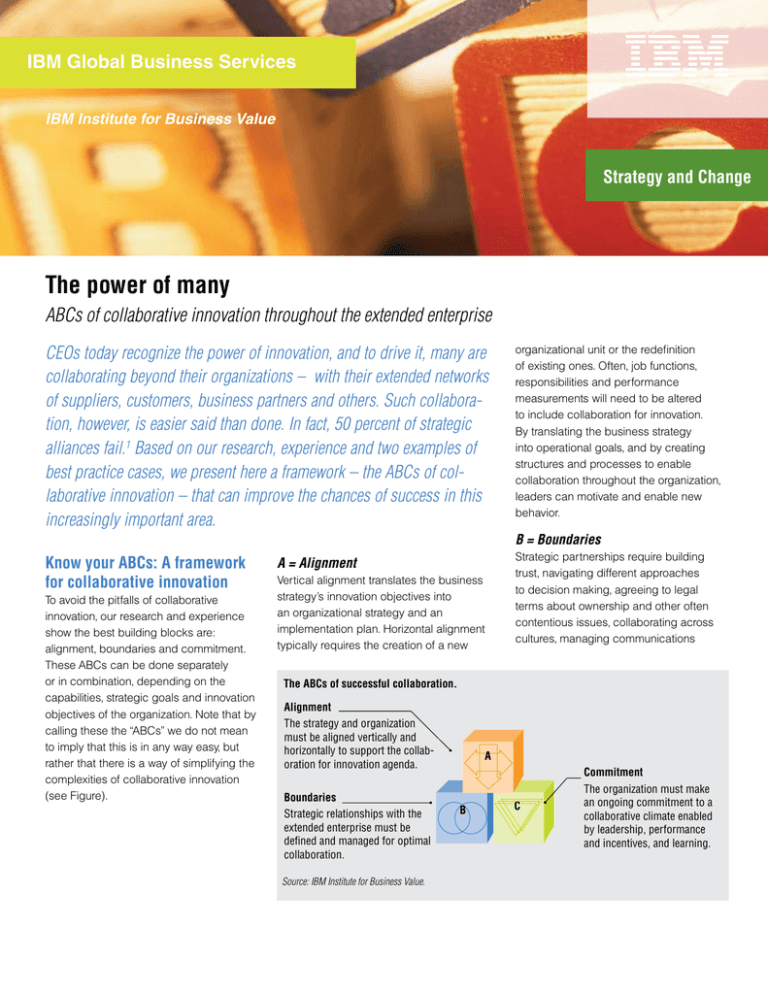
IBM Global Business Services
IBM Institute for Business Value
Strategy and Change
The power of many
ABCs of collaborative innovation throughout the extended enterprise
CEOs today recognize the power of innovation, and to drive it, many are
collaborating beyond their organizations – with their extended networks
of suppliers, customers, business partners and others. Such collaboration, however, is easier said than done. In fact, 50 percent of strategic
alliances fail.1 Based on our research, experience and two examples of
best practice cases, we present here a framework – the ABCs of collaborative innovation – that can improve the chances of success in this
increasingly important area.
organizational unit or the redefinition
of existing ones. Often, job functions,
responsibilities and performance
measurements will need to be altered
to include collaboration for innovation.
By translating the business strategy
into operational goals, and by creating
structures and processes to enable
collaboration throughout the organization,
leaders can motivate and enable new
behavior.
B = Boundaries
Know your ABCs: A framework
for collaborative innovation
To avoid the pitfalls of collaborative
innovation, our research and experience
show the best building blocks are:
alignment, boundaries and commitment.
These ABCs can be done separately
or in combination, depending on the
capabilities, strategic goals and innovation
objectives of the organization. Note that by
calling these the “ABCs” we do not mean
to imply that this is in any way easy, but
rather that there is a way of simplifying the
complexities of collaborative innovation
(see Figure).
A = Alignment
Vertical alignment translates the business
strategy’s innovation objectives into
an organizational strategy and an
implementation plan. Horizontal alignment
typically requires the creation of a new
Strategic partnerships require building
trust, navigating different approaches
to decision making, agreeing to legal
terms about ownership and other often
contentious issues, collaborating across
cultures, managing communications
The ABCs of successful collaboration.
Alignment
The strategy and organization
must be aligned vertically and
horizontally to support the collaboration for innovation agenda.
Boundaries
Strategic relationships with the
extended enterprise must be
defined and managed for optimal
collaboration.
Source: IBM Institute for Business Value.
A
B
C
Commitment
The organization must make
an ongoing commitment to a
collaborative climate enabled
by leadership, performance
and incentives, and learning.
and operations, and so on. Defining the
partnership, establishing governance
terms and then building a technological
and operational infrastructure for ongoing
collaboration across organizations can
significantly improve the chances of
success.
C = Commitment
Organizations that are serious about
collaborative innovation make an ongoing
commitment to transformation and
change. Creating a collaborative culture
happens over time through leadership
communication and reinforcement, the
development and ongoing tracking of key
measures, and institutionalized learning
and knowledge management to continually
develop key capabilities needed for
collaborative innovation.
Conclusion
As a vital part of an overall business
strategy, top CEOs recognize the need to
make organizational changes to support
collaborative innovation and derive profit
from valuable ideas, no matter where
they originate. The ABCs – alignment,
boundaries and commitment – provide
a framework for unlocking the power of
many, enabling collaborative innovation
throughout the extended enterprise and
improving performance.
To request a full version of this paper,
e-mail us at iibv@us.ibm.com
How can IBM help?
Key solutions relevant to the issues and opportunities raised in this study include:
• Strategy and Change: Fuses business strategy with technology insight to help organizations
develop, align and implement their business vision to drive innovation and growth
• Organization Change Strategy: Reduces transformation and operation costs by fully aligning
and focusing key stakeholders around transformation goals and business priorities
• Collaboration and Partnering: Helps organizations operationalize innovation strategy through
partnerships and collaboration - both internal and external
©Copyright IBM Corporation 2009
IBM Global Services
Route 100
Somers, NY 10589
U.S.A.
Produced in the United States of America
February 2009
All Rights Reserved
IBM, the IBM logo and ibm.com are trademarks
or registered trademarks of International
Business Machines Corporation in the United
States, other countries, or both. If these and
other IBM trademarked terms are marked
on their first occurrence in this information
with a trademark symbol (® or ™), these
symbols indicate U.S. registered or common
law trademarks owned by IBM at the time this
information was published. Such trademarks
may also be registered or common law
trademarks in other countries. A current list
of IBM trademarks is available on the Web at
“Copyright and trademark information” at
ibm.com/legal/copytrade.shtml
Other company, product and service names
may be trademarks or service marks of others.
References in this publication to IBM products
and services do not imply that IBM intends to
make them available in all countries in which
IBM operates.
Reference
1 Ernst, David and James Bamford. “Your
Alliances Are Too Stable.” Harvard Business
Review. June 2005.
Key contacts:
IBM Institute for Business Value
Amy Blitz, ablitz@us.ibm.com
Global Organization Change Strategy
Lawrence Owen, owenl@us.ibm.com
Americas Organization Change Strategy Charlie Goldwasser, charlie.goldwasser@us.ibm.com
Europe Organization Change Strategy
Hans-Henrik Jorgensen, hans-henrik.jorgensen@de.ibm.com
Asia Pacific Organization Change Strategy Christina Kirk, christina.kirk@au1.ibm.com
Japan Organization Change Strategy
Hiroshi Maruyama, MARUHI@jp.ibm.com
GBE03169-USEN-01



